The "dun" gene has 2 alleles that can affect the coat colour of a horse: the dun dilution and non-dun1.
¶ Phenotype
Dun both dilutes the coat and causes primitive markings, while non-dun1 creates primitive markings only.
¶ Dun
Dun dilutes both red and black pigment. It mainly lightens the body while the head, lower legs, mane, tail and primitive markings of the horse are mostly unaffected and retain the underlying base colour. This may create a strong contrast between the lighter body and dark points and primitive markings. Dun may also cause frosting, light hairs on the sides of the mane and/or tail. Not all primitive markings are always present on each horse, and the degree to which they are expressed may also differ between horses:
- Dorsal stripe = A long, dark line on the back that follows the spine all the way down into the tail. The dorsal stripe is always present on dun horses (except when it is covered by white patterns). The width of the stripe may vary between horses. A typical characteristic of dun is that the dorsal stripe goes through the tail, and often the mane as well, so a darker-coloured centre can be seen in these long hairs. This can help differentiate between a dorsal stripe created by dun, a dorsal stripe created by non-dun1, and a “fake dorsal” created by sooty. Sooty can sometimes cause a broad stripe over the back, which is likely a form of countershading.
Some dorsals will have short stripes that extend perpendicular from the dorsal stripe, creating a fish grate-like pattern. - Leg barring = Leg barring also referred to as zebra or tiger stripes, is horizontal striping on the legs of dun horses. The stripes are usually behind the knees and to the sides of the hocks. On darker horses with extensive black points, the leg stripes may be missing or hard to see.
- Shoulder stripe = A transverse stripe on the shoulder area. This may vary from just a light shadow or smudge near the withers, to multiple stripes that extend up to the neckline of the horse.
- Bider markings = Dark spots or cobweb-like patterns that may appear on the shoulder area, seen in more “primitive” horse breeds.
- Body stripes = In rare cases, dun horses may have vertically oriented “brindle-like” stripes on their body. They follow a striping pattern similar to that of zebras.
- Cobwebbing or face mask = Cobwebbing, also called spider webbing, are concentric dark rings or fine stripes on the forehead or front of the face of dun horses. The (fore)head may also be entirely dark, often called a face mask.
- Ear tips = The ear tips of dun horses may be darker in colour and show some barring. In some cases, the ears may have a white tip at the end.
| Dun - Irish Cob Horse | |
| Example | Information |

|
Chestnut dun Chestnut dun horses have a dull light apricot to orange-red colour, with points and primitive markings that have a darker red shade. Chestnut dun is the most easily overlooked, as there is less contrast between the body and the points and primitive markings. Chestnut duns are sometimes called claybank (dun). |
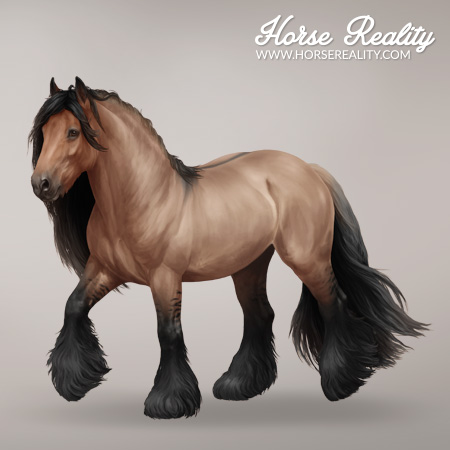
|
Bay dun Bay dun, also called classic dun, or zebra dun, results in a horse diluted to a tan or golden colour with dark points and primitive markings. It may be mistaken for buckskin, as both can have similar colour shades. |

|
Brown dun (seal brown + dun) Dun on a seal brown base creates a much darker colour. The extensive black points may cause the primitive markings to be harder to see. |
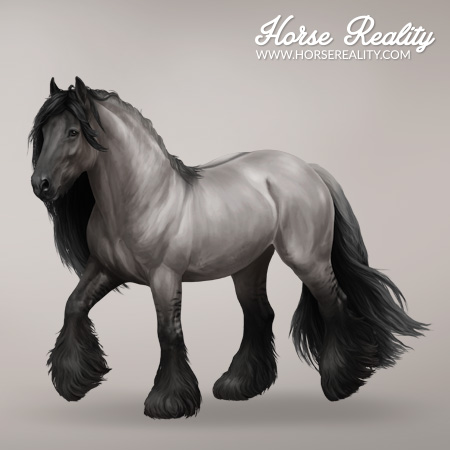
|
Black dun Black dun is also known as mouse dun, blue dun, or grullo or grulla. Grullo means crane in Spanish, which refers to the typical blue-grey colour of black dun horses. Grullo may be used for stallions and geldings while grulla is used for mares, but grullo can also be used for all horses. The shade of black dun horses may vary from a light silvery grey, sometimes with a beige tint, to being quite dark; again with dark points and primitive markings. |
¶ Fjord Horse
The Fjord Horse is famous for its universal dun colour and its unique naming system for the several colour variations. These can be found below:
| Dun - Fjord Horse | ||
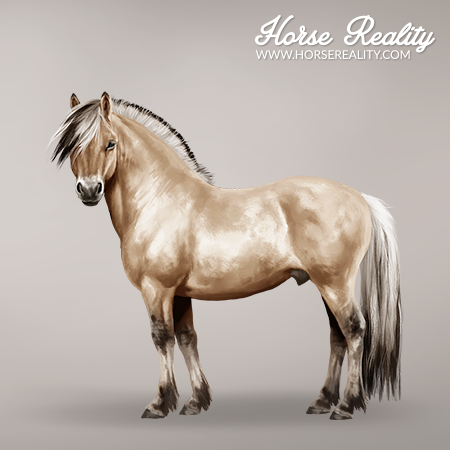
Bay dun |
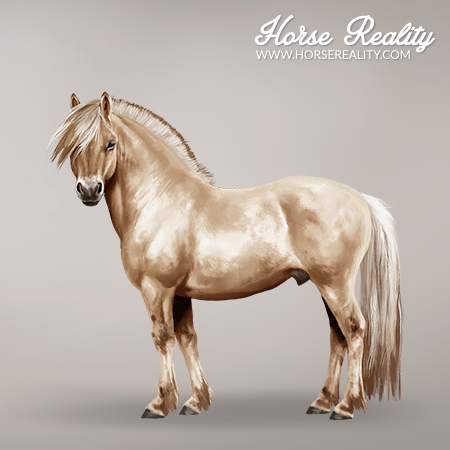
Chestnut dun |

Black dun or smoky black dun |
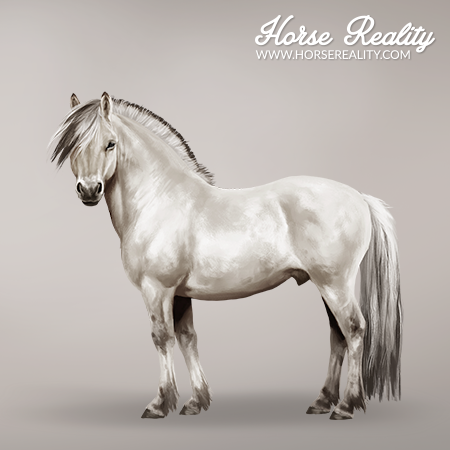
Dunskin (buckskin dun) |

Dunalino (palomino dun) |
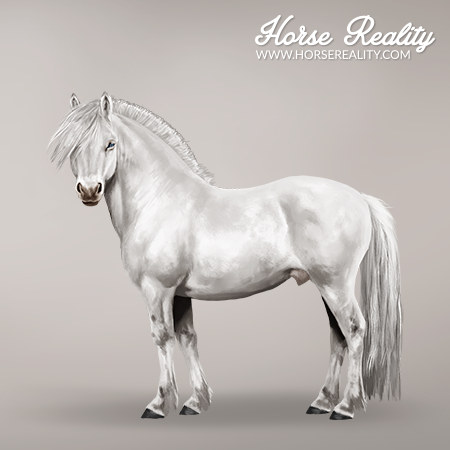
Homozygous cream dun |
¶
Non-Dun1
Non-dun1 causes primitive markings but lacks the dilution of the coat that dun produces. Sometimes, it may cause a very slight lightening of the coat. It is suspected that non-dun1 may make horses more susceptible to sun-fading in real life. The dorsal stripe is usually the most notable primitive marking on non-dun1 horses, but unlike the dorsal stripe of dun horses, it doesn't travel through the tail of the horse.
| Non-Dun1 - Namib Desert Horse | |
| Example | Information |
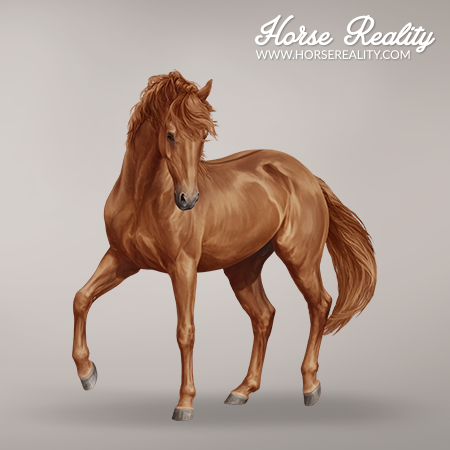
|
Chestnut non-dun1 Chestnut-based non-dun1 appears the same as a chestnut horse, but with a darker red dorsal stripe and possibly other primitive markings. |
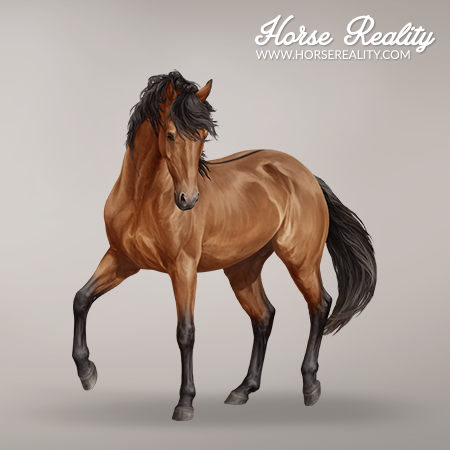
|
Bay non-dun1 Non-dun1 on a bay base colour creates a distinct dorsal stripe and possibly other primitive markings. |
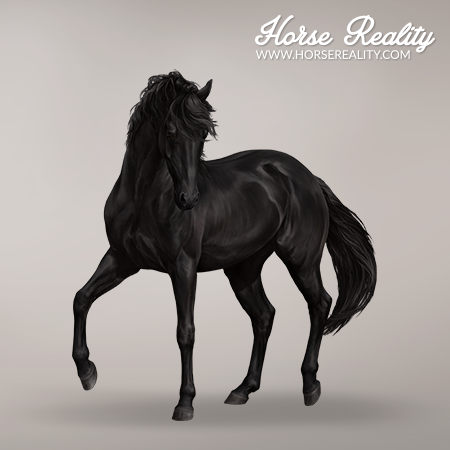
|
Black non-dun1 Non-dun1 on black horses is easily overlooked, since the dorsal stripe or other primitive markings may be hard to see on the dark, mostly undiluted coat. Black non-dun1 horses may have a lighter grey colour on the inside of their ears. |
¶ Genotype
Dun is caused by the dominant D-allele of the TBX3 gene, which causes an uneven pigment distribution in the hair shaft. The dilution and primitive markings that dun causes, do not differ between horses that are homozygous or heterozygous.
This gene has 2 other possible alleles: non-dun1 (nd1) and non-dun2 (nd2). Non-dun1 is recessive to dun, but dominant over non-dun2. Non-dun1 horses also have a slight asymmetry of pigment distribution in their hair shafts, leading to their primitive markings. Homozygous non-dun1 may sometimes cause the primitive markings to appear more clearly than on heterozygous non-dun1 in real life, but there is no difference between them on Horse Reality. Non-dun2 causes neither dilution nor primitive markings on the coat.
The order of dominance is as follows: D > nd1 > nd2. Below, the resulting phenotype of each genotype is listed:
- D/D = Dun (dilution + primitive markings)
- D/nd1 = Dun
- nd1/nd1 = Non-dun1 (primitive markings)
- nd1/nd2 = Non-dun1
- nd2/nd2 = No dilution nor primitive markings
The D-allele has been found in pre-domestication horses and several closely related species (asses, zebras, Przewalski Horses,…), indicating that it is a very old dilution. It is considered to be the wild-type allele, meaning that all horses were originally homozygous dun, and that the nd1-allele and later nd2-allele were mutations.
The presence of dun and nd1 can be tested at the Laboratory.
¶ Breeds
Since it is such an old dilution, dun is present in many horse breeds. It is very common among feral and wild horses, and can also be found in many pony breeds. The table below lists all breeds that currently have the dun (D) and/or non-dun1 (nd1) alleles in-game.
| Breeds |
| Akhal-Teke - nd1 |
| Arabian Horse |
| Brabant Horse |
| Brumby Horse - D |
| Camargue Horse |
| Cleveland Bay |
| Exmoor Horse - D |
| Finnhorse |
| Fjord Horse - D |
| Friesian Horse |
| Haflinger Horse - nd1 |
| Icelandic Horse - D, nd1 |
| Irish Cob Horse - D |
| Kladruber Horse |
| Knabstrupper - D, nd1 |
| Lipizzaner - nd1 |
| Lusitano - nd1 |
| Mongolian Horse - D, nd1 |
| Mustang Horse - D |
| Namib Desert Horse - nd1 |
| Noriker Horse |
| Norman Cob |
| Oldenburg Horse - nd1 |
| Pantaneiro Horse - D, nd1 |
| Pura Raza Española |
| Quarter Horse - D |
| Shetland Pony - D, nd1 |
| Shire Horse |
| Suffolk Punch |
| Thoroughbred - nd1 |
| Trakehner Horse |
| Welsh Pony - D |
¶ Changelog
- On June 28th 2023, nd1 was added to the Haflinger Horse[4]
- On May 20th 2025, nd1 was added to the Akhal Teke[5,6]
- On October 25th 2025, nd1 was added to the Oldenburg Horse[7,8]
¶ References
- Bellone R., Sponenberg D. P., Equine Color Genetics, 4th Edition, 2017, Wiley-Blackwell
- UC Davis Veterinary Genetics Laboratory; https://vgl.ucdavis.edu/test/dun-horse; Access: December 2022
- The University of Sydney, Online Mendelian Inheritance in Animals (OMIA); https://omia.org/OMIA001972/9796/; Access: December 2022
- https://v2.horsereality.com/news/136/community-update-28th-june
- https://v2.horsereality.com/news/52/community-update-v2-market-postponed-preparing-3rd-foundation-generation-about-breed-redos-new-art-intern-march-background
- https://v2.horsereality.com/news/226/release-notes-the-2nd-migration-batch
- https://v2.horsereality.com/news/258/announcement-the-4th-migration-batch-arrives-nov-25
- https://v2.horsereality.com/news/259/release-notes-the-4th-migration-batch